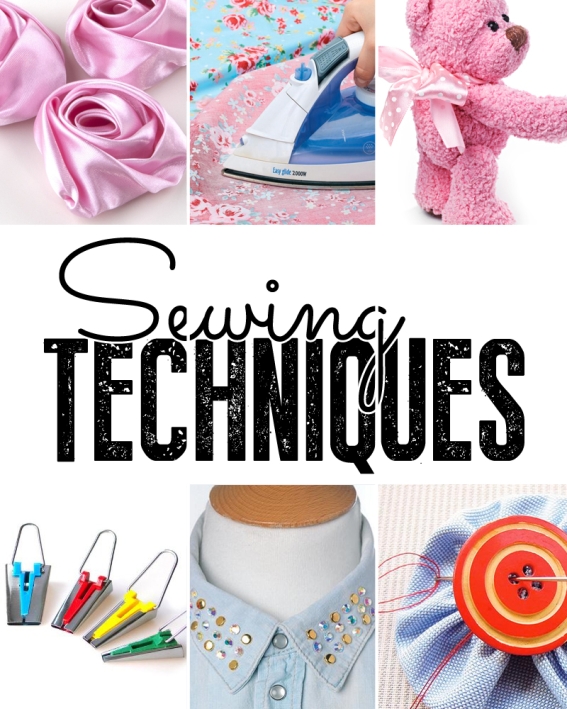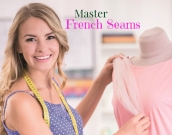
Sewing techniques
Learn something new to add to your sewing repertoire here!
How to make yo yos




Draw circles onto the wrong side of a piece of fabric, using a template such as a glass. Note that the finished yo yo will be roughly half the size of the circle. Cut out
Sew a running stitch around the edge of the circle using coordinating thread.
When you reach the startof your stitches, pull on the thread to gather the circle. Continue until the edges of the circle meet one another in the middle.
Adjust the yo yo so that it lies flat and the fabric is evenly distributed around the circle. Once you are happy with the overall shape, work a few stitches across the middle, from one side of the fabric to the other, so that the shape stays put.
Stitch a button into place in the middle of your gathered circle, using the thread that is still attached to your work. This will make your finished yo yo both strong and neat.
How to make ribbon roses
Thread your needle with two strands of embroidery thread in a colour which closely matches the ribbon you’re using. Work a fly stitch to create three spokes, then do two further straight stitches, so that you have five straight stitches radiating out from a central point. Fasten off the thread at the back of the work.
Take the needle under one of the spokes then, working anti-clockwise, take it over the next spoke, under the next, over the next and so on, working outwards from the centre and twisting the ribbon from time to time. Continue until you have gone round about three or four times and reached the outer edge of the five spokes. Then take the needle through to the back of the work and fasten off.
How to apply Lamifix



Select your cotton fabric and cut to size. Steam press so it is completely crease-free and leave to cool. Place onto your ironing surface and lay a same-sized sheet of Lamifix on top, glossy side up. Ensure there is no fluff or fibres between the two layers and smooth over the top to remove any air pockets.
Carefully lay another piece of cotton fabric over the top of the Lamifix before slowly ironing the sandwich with a wool/cotton heat and no steam. Work methodically from side to side. Remove the top layer of fabric to check the film has adhered to the patterned material without air bubbles or creases. At this point the Lamifix can still be peeled away from the surface and repositioned if necessary.
Once you are happy that the film will bond successfully, recover the Lamifix, set the iron to a higher heat with no steam and press again. Allow the iron to move slowly across the surface so that each area has heat for around eight seconds. Leave the bonded film and fabric to cool completely before using.
How to make bias binding
The bias of a piece of fabric is a 45 angle from the selvage of the material. For this project the strips need to be 4cm wide and as long as the fabric will allow. You may need to join the bias strips to make enough to attach to the length of the neckline, do this by laying and stitching the two ends at right angles to each other, making sure that the right sides of the fabric are facing each other. When the bias is opened the strip will continue in one line. Pass the bias strip through a bias binding folder, pressing the folds in as you pull the folder along the strip. Carefully fold and press the binding in half again lengthways.
How to stuff your toy
Work with small pieces of stuffing to produce fewer lumps.
Stuff extremities such as the hooves first. Use a tool like a knitting needle, pencil, dowel or stuffing fork for hard to reach areas.
Pack the filling tightly and close the openings with a ladder stitch.
An easy method to weigh down a toy is to use sand. Sew a small cloth pouch on three sides (double-sew the seams to be safe) and fill with fine grain sand. Securely sew the opening closed, then nestle the bag in wool stuffing before placing inside the toy.
How to Apply hot fix crystals



Plan your design before heating up the tool. If you’re doing a simple pattern, check you have all the colours and sizes to hand. Lay them out, glue side down on a hard surface, ready to apply.
Screw the correct size tip into the tool, heat it up for about two minutes and then lightly pick up the stone with the end.
Watch as the applicator heats the crystal and melts the special hot fix glue. When it glistens and starts to bubble slightly, it is ready to apply. This only takes a few seconds for small stones.
Touch the fabric with the glue end of the crystal to apply it exactly where you want it. Press gently for just a few seconds to ensure it bonds fully with the fabric and then pull the applicator away.
How to use a bias binding tool
Using a bias binding tool can ease the process of making your fabric tape. Pieces of fabric are fed through a metal channel, where the edges are folded and can be pressed in place whilst working along the length. Fold and press the binding in half again to finish.
How to embellish a collar



Unfold the collar of a plain shirt and iron flat.Gather a selection of claw studs and adhesive rhinestones in the desired size, like these Josy Rose versions. Position a stud on the collar and push the claws through the fabric.
Check that you are satisfied with the positioning; changing if necessary. When happy, turn the collar over and make sure the fabric is taut. Push the claws down flat, using needle-nosed pliers to secure.
Repeat the process with more studs. Also try alternating them with adhesive rhinestones. Simply peel the stones from the backing and stick to the collar adding extra adhesive.










































